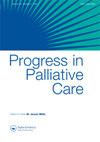将姑息治疗纳入初级卫生保健:印度人的观点
IF 0.8
Q4 PUBLIC, ENVIRONMENTAL & OCCUPATIONAL HEALTH
引用次数: 0
摘要
获得姑息治疗在初级卫生保健中至关重要,因为大多数患者和家属更喜欢在家中进行临终关怀。然而,往往缺乏将姑息治疗纳入社区,从而破坏了护理的连续性。在印度这样的中低收入国家,姑息治疗通常由三级和二级医院提供。在印度的一些地区,如喀拉拉邦,通过社区姑息治疗规划网络偶尔提供初级姑息治疗。缺乏训练有素的医务人员、资金和认识限制了提供初级姑息治疗的能力。它导致人们在生命的最后阶段在急症医院接受治疗,接受不必要的医疗干预,并降低了他们的死亡质量。在像印度这样的中低收入国家,需要在社区发展姑息治疗。本文章由计算机程序翻译,如有差异,请以英文原文为准。
Integrating palliative care into primary health care: Indian perspectives
Access to palliative care is essential in primary healthcare as most patients and families prefer end-of-life care at home. However, integrating palliative care into the community is often lacking, disrupting the continuity of care. In a low-middle-income country like India, palliative care is usually provided in tertiary and secondary hospitals. Primary palliative care is sporadically offered in some parts of India, like Kerala, through a neighbourhood network of palliative care (NNPC) programmes. The availability of trained providers, funding, and awareness, limits the capacity to provide primary palliative care. It leads to people accessing care at their end of life in acute hospitals, receiving unnecessary medical interventions, and diminishing their quality of dying. The need for developing palliative care in the community in a low-middle-income country like India is explicated here.
求助全文
通过发布文献求助,成功后即可免费获取论文全文。
去求助
来源期刊

PROGRESS IN PALLIATIVE CARE
PUBLIC, ENVIRONMENTAL & OCCUPATIONAL HEALTH-
CiteScore
2.60
自引率
11.80%
发文量
24
期刊介绍:
Progress in Palliative Care is a peer reviewed, multidisciplinary journal with an international perspective. It provides a central point of reference for all members of the palliative care community: medical consultants, nurses, hospital support teams, home care teams, hospice directors and administrators, pain centre staff, social workers, chaplains, counsellors, information staff, paramedical staff and self-help groups. The emphasis of the journal is on the rapid exchange of information amongst those working in palliative care. Progress in Palliative Care embraces all aspects of the management of the problems of end-stage disease.
 求助内容:
求助内容: 应助结果提醒方式:
应助结果提醒方式:


